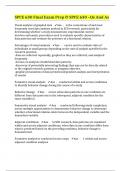Thanyha Kirisanker
BTEC Childcare
Unit 5 Keeping Children Safe
P6 P7 M4 D3
Hazards and Risk
A hazard is something that has the potential to cause harm. A risk is the possibility that
someone will be hurt because of the hazard. Teachers must undertake risk assessments for
risks such as assessing the place before children come and utilise it, and this must be done
both inside and outside. Risk assessments are a procedure that may be done both formally
and informally. When the risks are deemed considerable, a formal risk assessment is
required. The risk assessment should be documented, but you must adhere to the unique
risk assessment approach for your settings. The risk assessment process includes looking at
an area, activity, or resource and identifying what hazards or risks may be associated with it,
deciding who the risk may apply to and how they may be harmed, evaluating the risk, and
deciding how it will be managed, such as what precautions will be taken, recording this
information accurately and coherently on a sheet, signing and dating the sheet, and
ensuring the precautions are implemented. Early years providers are expected to undertake
frequent risk assessments to identify components of the environment that must be
evaluated on a regular basis since children can easily slip and fall or trip, and risk
assessments can assist the setting in ensuring that these dangers are minimised. 'Providers
must ensure that they take all reasonable means to ensure that employees and children in
their care are not exposed to hazards and must be able to demonstrate how they are
managing risks,' according to the EYFS Statutory Framework. Providers must evaluate where
it is beneficial to do written risk assessments in connection to specific situations, to educate
staff practise, and to explain how they are managing risks if requested by parents,
caregivers, or inspectors. Risk assessments should identify environmental features that must
be evaluated on a regular basis, when and by whom those aspects will be reviewed, and
how the risk will be eliminated or reduced.1
In my placement, I was asked to carry out an activity I chose to do a playdough activity, so I
assessed the risk assessments before setting up the activity which was to make sure not to
set up the activity near the fire exit as if there was a fire drill/alarm children and staff would
not be able to exit safely out the building so setting up the activity away from the fire exit
and keeping the exit clear would help to avoid any injuries to the children and staff if they
need to quickly exit. The next risk I identified was if the activity was set up to be carried out
on the floor instead of the table can cause the playdough to stick to the floor which can
cause the children to slip on it or trip over it if a big piece of playdough is stuck to the floor.
So, to avoid any of the children hurting themselves the activity should be set up on a table
to avoid any children falling or slipping over the playdough.
Risk evaluations are required for indoor areas for factors like the temperature of the rooms
in the setting. This is because room temperature should be kept at a level that ensures the
comfort of both children and employees. Temperatures in various portions of the school
should be checked and monitored on a frequent basis, particularly in hot or cold weather.
According to the Health and Safety Executive, an appropriate working temperature for
people in a work environment is at least 16°C. The safety and well-being of the children
comes first, thus precautions should be made during hot weather to prevent rooms from
1
https://assets.publishing.service.gov.uk/government/uploads/system/uploads/attachment_data/file/
974907/EYFS_framework_-_March_2021.pdf
1
, Thanyha Kirisanker
BTEC Childcare
Unit 5 Keeping Children Safe
P6 P7 M4 D3
being overheated. Early years providers must ensure that the safety of children was heating
appliances, including radiators, are used to ensure that the children do not get scalded or
burnt.2
The temperatures of the hot and cold water should be tested monthly at various places
throughout the water system. These temperatures should then be recorded so that they can
be tracked over time to assist enhance the legionella risk management and control
approach in place. Certifact Services LTD is responsible for ensuring that the indicated
operational control is carried out and recorded in the school's waterlog book in my work
placement at Sherwood Park, where a water risk assessment was performed on July 1st,
2021. The risk assessment will be reassessed every two years and/or whenever substantial
modifications to the water system and/or building footprint occur. The risks from legionella
are mitigated by the following controls which are temperature checks, heating of water, TVC
sampling and legionella sampling.3
For outings, outside risk assessments are required. It is critical to carefully arrange trips and
to engage children and their families in the evaluation process. 'Children must be kept
secure when on trips,' according to EYFS requirement 3.65. Providers must analyse the risks
or dangers that may occur for the children and determine the activities that must be done
to eliminate, reduce, or manage such risks and hazards. The risk assessment does not have
to be in writing; this is up to the providers to decide.' When visiting major venues such as
farms and zoos, they may include risk assessments on their website that can assist you in
evaluating all the dangers and determining how to avoid them. An important aspect is hand
washing especially if the outing is taking children to a zoo or farm. Taking alcohol free wipe
and hand sanitisers is essential. It is important to also check if there are child-friendly toilets
with sink and soap, running water.4 Two weeks before an outing, Sherwood Park conducts a
risk assessment to detect potential concerns. The risk assessment must include who could
be affected by a hazard identified, as well as what measures might be taken to decrease the
risks to an acceptable level. A Plan B scenario should be included as part of the risk
assessment. Before the trip, the risk assessment should be addressed with and approved by
the Head Teacher. If a risk assessment has not been considered and approved, the
headteacher reserves the authority to cancel a trip even on the day of departure. It should
be signed by the lead adult attending the trip and placed in the Educational Visits Folder in
the School Office.5 Prior to every educational tour that requires students to leave the school
grounds, the class teacher will complete a risk assessment and upload it to Evolve. On
school outings and visits, there will always be at least one first aider with a current
paediatric first aid certificate, as required by the statutory framework for the Early Years
Foundation Stage.6
2
https://app.croneri.co.uk/topics/early-years-premises/indepth
3
https://www.sherwoodparkprimary.co.uk/bexley/primary/sherwood/arenas/websitecontent/web/Health
%20&%20Safety%20Policy%202021-21103.pdf
4
https://www.childcare.co.uk/information/outings-risk-assessments
5
https://www.sherwoodparkprimary.co.uk/bexley/primary/sherwood/arenas/websitecontent/web/
Educational%20Visit%20Policy-57100.pdf
6
https://www.sherwoodparkprimary.co.uk/bexley/primary/sherwood/arenas/websitecontent/web/Draft
%20First%20Aid%20Policy-3061.pdf\
2













